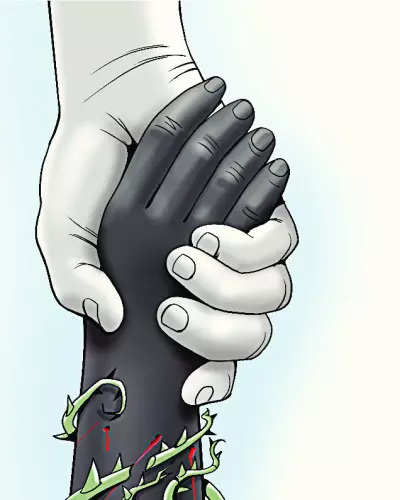Last month, another student at IIT Guwahati was allegedly found hanging in her room. This issue is not confined to premier institutions like IITs. The Kota hub, known for its coaching centers, is also a major concern. Reports indicate that 14 students have committed suicide in Kota this year alone. In 2023, there were 26 incidents. Data from previous years shows a troubling trend: 15 incidents in 2022, 18 in 2019, 20 in 2018, 17 in 2017, and 18 in 2016.
A report by the National Crime Records Bureau (NCRB) reveals that the student suicide rate in India has surpassed both the population growth rate and overall suicide trends. While the general suicide rate has increased by 2 percent annually, student suicides have surged by 4 percent.
“Over the past two decades, student suicides have grown at an alarming annual rate of 4 percent, double the national average. In 2022, male students accounted for 53 percent of total student suicides. Between 2021 and 2022, male student suicides decreased by 6 percent, while female student suicides increased by 7 percent,” noted the report compiled by IC3 Institute, as quoted by PTI.
The report highlighted the following points:
- The student suicide rate in India grows at 4 percent annually, twice the rate of overall suicides.
- Madhya Pradesh, Maharashtra, and Tamil Nadu account for a third of student suicides in India.
- Jharkhand and Rajasthan have shown a concerning increase in student suicides over the last five years.
- Between 2021 and 2022, India recorded over ninety thousand student suicides.
Major Factors Contributing to Student Suicides in India
Major factors contributing to student suicides in India include intense academic pressure, parental expectations, lack of emotional support, fear of failure, societal stigma around mental health, financial stress, bullying, inadequate counseling, peer pressure, and rigid education systems that prioritize grades over well-being.
- Academic Pressure: The intense competition to succeed in exams like NEET and JEE, combined with rigorous academic demands and the constant pressure to achieve high scores, can overwhelm students. This stress often leads to burnout and feelings of inadequacy, as seen in the ‘Kota hub’ example.
- Parental Pressure: High expectations from parents regarding academic performance and career choices can create significant emotional strain. For instance, in January of this year, an eighteen-year-old girl preparing for JEE committed suicide, leaving a note that read, “Mummy-Papa, I can’t do JEE, so I am taking this extreme step. I am a terrible daughter, sorry mummy-papa; this is my last option.”
- Bullying and Ragging: Experiences of bullying or ragging can lead to severe mental distress. A report by the National Medical Commission (NMC), prepared by the National Task Force on Mental Health and Wellbeing of Medical Students, highlighted that ragging is a significant issue. It emphasized the need for active anti-ragging cells and strict penalties for offenders. Among undergraduate students, 16.2% reported suicidal ideation, while 4.4% of postgraduate students attempted suicide last year.
- Financial Stress: The high cost of higher education and the burden of educational loans can cause significant anxiety. Many students face financial constraints that exacerbate their overall stress.
- Lack of Support: Many educational institutions lack sufficient guidance and emotional support. While some have counselors, many do not, leaving students without access to adequate mental health resources. The absence of a supportive environment can make it difficult for students to cope with their challenges.
Measures to curb student suicides in India
Steps to curb student suicides in India require government initiatives for mental health support, parental awareness about emotional well-being, and educational institutes fostering less pressure-driven environments. Comprehensive counseling, peer support programs, and open dialogues about mental health are crucial for prevention and support.
Government
- Guidelines on Self-Harm: Last year, the Ministry of Education issued draft guidelines to schools aimed at enhancing sensitivity, understanding, and support in cases of reported self-harm. These guidelines emphasize the importance of nurturing partnerships between schools, parents, and the community to foster societal support as a critical strategy for preventing suicide and reducing the stigma associated with suicidal behavior. It is essential that similar guidelines are developed and implemented effectively.
- Strengthening Anti-Ragging Laws: In 2001, the Supreme Court of India had banned ragging across educational institutions. Following the tragic death of Aman Kachru in 2009 due to ragging, the Court mandated strict adherence to anti-ragging laws by all institutions. Despite this, incidents of ragging continue. The government must enforce stricter anti-ragging laws and ensure rigorous compliance by educational institutions.
- Expanding Mental Health Initiatives: The government should increase funding and support for mental health programs specifically targeting educational institutions. Establishing dedicated suicide prevention helplines and raising awareness about these resources is crucial.
Parents
- Foster Open Communication: Parents should encourage open dialogues about academic pressures and mental health. While setting reasonable expectations is understandable, it is crucial to avoid forcing career choices upon children based on external pressures. Instead, offer emotional support and create a nurturing environment where students feel comfortable sharing their struggles without fear of judgment.
- Provide Guidance When Necessary: If you notice your child struggling or feeling overwhelmed, seek professional help. This not only supports their mental health but can also improve their academic performance. Encourage a balanced lifestyle by supporting extracurricular interests and focusing on holistic development, rather than solely on academic achievement.
Educational Institutions
- Enhance Counseling Services: Every educational institution should have accessible counseling services. Promote mental health awareness, establish peer counseling programs, and ensure that students have access to professional counselors.
- Implement Stress Management Programs: Introduce stress management and emotional resilience programs as part of the curriculum. Conduct regular workshops on mindfulness, stress management, and coping strategies to help students handle academic pressure.
- Strengthen Anti-Ragging Policies: Although many institutions have anti-ragging policies, incidents of ragging and bullying persist. Institutions should enforce strict anti-ragging policies and take immediate action against offenders. Establish clear rules and preventive measures for ragging in hostels as well.
If you or someone you know is having thoughts of self-harm, please seek help immediately. You can find resources in India here.


